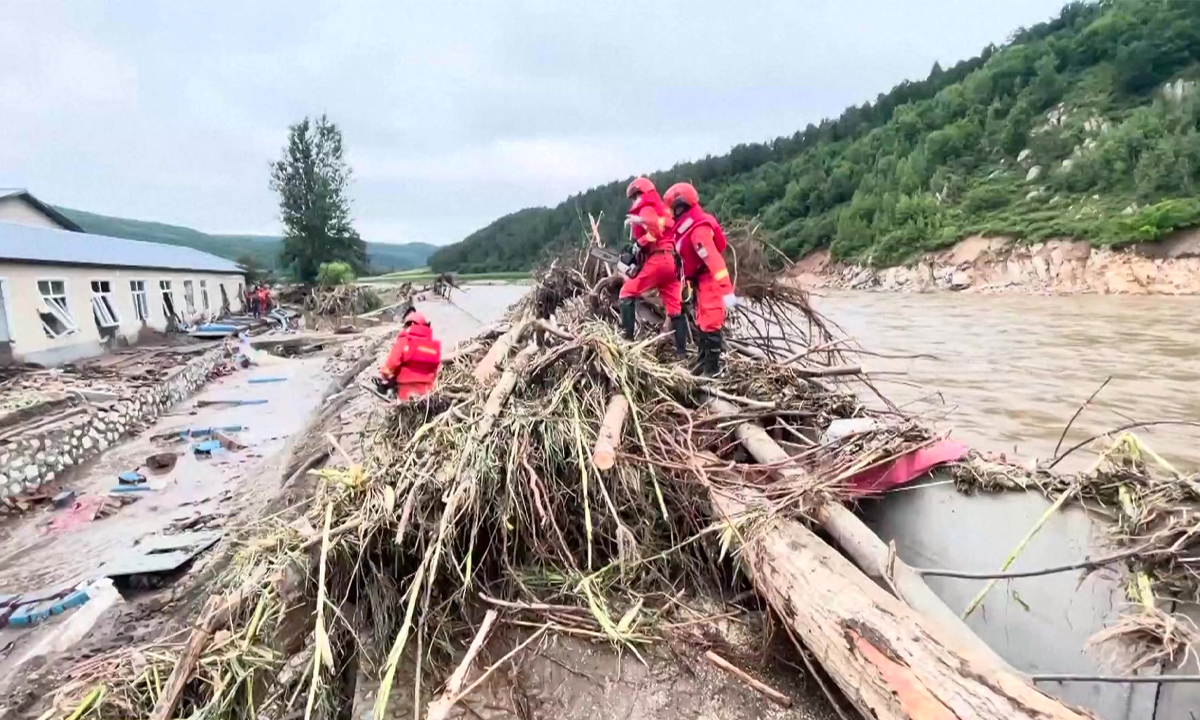
Firefighters remove trees destroyed by flooding from the road in Hailin, Northeast China's Heilongjiang Province, on August 7, 2023. Photo: VCG
Multiple regions in Northeast China have raised the level of emergency response to flooding and issued meteorological warnings as some areas are facing challenges caused by intensified floods that have endangered people's lives, homes, as well as farmland. Known as the country's "grain barn," Northeast China's Heilongjiang Province on Monday released a
disaster relief plan for flood-hit agricultural production.
In Heilongjiang Province, 12 rivers have exceeded warning level, and 26 reservoirs are operating over the limit by 0.03 to 1.95 meters, Heilongjiang authorities said on Monday. Songhua River in Northeast China saw its first flood of the year on Monday, with water levels at the Jiamusi monitoring station reaching 79.30 meters at 8 pm and continuing rising, the Ministry of Water Resources said on Monday.
Some villages along the river in Wuchang, a city famous for its rice, have flooded, as well as experienced large-scale waterlogging.
Heilongjiang, which accounted for 11.3 percent of the country's total grain output in 2022, vowed to ensure agricultural production targets through a
disaster relief plan, in which it called for multiple measures, including speeding up field drainage to minimize the time of waterlogging, strengthening control of pests and diseases and farmland management and scientific prevention.
"In disaster-affected areas, agricultural production has definitely been affected, but how much damage has been done depends on the crop," Li Guoxiang, a researcher at the Rural Development Institute of the Chinese Academy of Social Sciences, told the Global Times on Monday. Li said that for instance, if waterlogging can be eased to a short term in rice farms, there will still be an opportunity for production to recover.
So far, flooding has been regional so it's still too early to judge the entire situation across the country, as agriculture production in most of the country has not been significantly affected, according to Li.
Along with Heilongjiang, Northeast China's Jilin Province has also been heavily hit by flooding. As of 10 pm on Sunday, 14 people had been killed and one remained missing in Shulan, a city in Jilin, according to the local authorities. Three officials in Shulan, including the executive deputy mayor Luo Xudong, died while fighting the flood.
Three officials died when fighting the flood on the front lines of rescue and disaster relief in the province.
Top-down coordination and nationwide unity have formed ever since North China and Northeast China were hit by the heavy rainfall.
Xu Qin, secretary of the Communist Party of China Heilongjiang Provincial Committee, chaired a meeting on flood control and disaster relief on Sunday night, during which he called for all-out effort to relocate residents and that they would rather be scolded by those who are reluctant to evacuate than listen to their cries for help, according to local media reports.
The Office of the State Flood Control and Drought Relief Headquarters and the Ministry of Emergency Management on Sunday continued to deploy flood control and disaster relief work in key regions, and reminded Tianjin, Jilin, Heilongjiang, and other areas to strengthen inspection of dikes and levees.
North China's Tianjin Municipality issued a red alert on Sunday, the highest warning level, for possible floods along the Daqinghe River. As of Monday afternoon, the city was still experiencing flooding, with flood water from the Yongding and Daqing rivers entering flood storage areas, Tianjin authorities said on Monday.
Chinese authorities on Sunday deployed an additional 350 million yuan ($48.66 million) to assist disaster relief, emergency response and relocation of residents in flood-hit regions in North China's Beijing, Tianjin, Hebei Province, and Northeast China's Heilongjiang and Jilin provinces.
China's meteorological departments warned on Monday that Khanun, the sixth typhoon of the year, is forecast to bring heavy rainfall to some regions in Northeast China from Thursday to Saturday, with accumulated precipitation possibly reaching 200 millimeters regionally.
Over the past five days, the accumulated precipitation in central and southern Heilongjiang, northern and central Jilin, and eastern Liaoning have exceeded 50 millimeters, with some regions such as southern Harbin approaching or even exceeding 100 millimeters, according to meteorological authorities on Monday.
From Wednesday to Saturday, the southern region of Heilongjiang Province suffered the strongest rainstorm disaster since meteorological records began, with some areas of Harbin and Mudanjiang hit the hardest.




